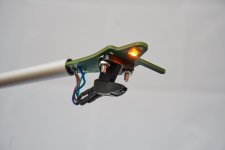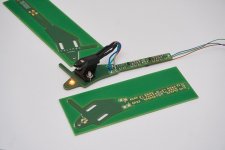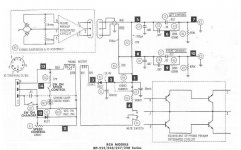Dear all,
phono signals being so low-level (and as such, much more susceptible to noise pickup), wouldn't it be a great idea to mod an acceptably priced tonearm and put a tiny little phono preamp's PCB just right behind the cartridge ?
This way a good healthy 2V (average) signal could go all the way through the tonearm and through the RCA outputs to a normal standard line stage input of the amplifier.
Most probably done with ICs/opamps, either with or without RIAA, the point is to amplify the signal right after the pickup so that we have a better SNR compared to conventional methods, when the phono signal arrives at the amplifier's input.
And we're talking about some tiny grams here I think.. it might look a bit weird at first sight but I think the additional weight of such a tiny PCB would even be less than a somewhat heavier tonearm.. easily within spread.
I can't imagine why nobody has tried such yet. Really so much off-the-road ?
phono signals being so low-level (and as such, much more susceptible to noise pickup), wouldn't it be a great idea to mod an acceptably priced tonearm and put a tiny little phono preamp's PCB just right behind the cartridge ?
This way a good healthy 2V (average) signal could go all the way through the tonearm and through the RCA outputs to a normal standard line stage input of the amplifier.
Most probably done with ICs/opamps, either with or without RIAA, the point is to amplify the signal right after the pickup so that we have a better SNR compared to conventional methods, when the phono signal arrives at the amplifier's input.
And we're talking about some tiny grams here I think.. it might look a bit weird at first sight but I think the additional weight of such a tiny PCB would even be less than a somewhat heavier tonearm.. easily within spread.
I can't imagine why nobody has tried such yet. Really so much off-the-road ?
Yamaha made two such phono amplifiers at the end of the 1970s, the HA-2 and HA-3.
HA-2(ヤマハ) | ガラクタ再生工房
The “satellite amp” referred to in the schematic is located at the tonearm headshell.
HA-2(ヤマハ) | ガラクタ再生工房
The “satellite amp” referred to in the schematic is located at the tonearm headshell.
Clearaudio still do it. clearaudio electronic GmbH - absolute phono, The world's first active headshell moving coil phonostage
The killer is that, you either need more wires down the tonearm, or phantom power which means big electrolytic caps.
In reality, although it's a fun engineering challenge the advantages are minimal. For MC the gain is marginal, and for MM, where it does matter more, putting the amplifier in the plinth is just as good.
A recent DIY approach shown which I think was posted on here, but cannot find again now. Requires a DIY arm to go with it, but a lot of fun and hats off for the packaging.
The killer is that, you either need more wires down the tonearm, or phantom power which means big electrolytic caps.
In reality, although it's a fun engineering challenge the advantages are minimal. For MC the gain is marginal, and for MM, where it does matter more, putting the amplifier in the plinth is just as good.
A recent DIY approach shown which I think was posted on here, but cannot find again now. Requires a DIY arm to go with it, but a lot of fun and hats off for the packaging.
Attachments
The following page discusses making a DIY version of the HA-2's satellite module.
http://www13.plala.or.jp/mj4018/ha-2.html
http://www13.plala.or.jp/mj4018/ha-2.html
I can't imagine why nobody has tried such yet. Really so much off-the-road ?
It has been tried many times. Perhaps beginning with Ortofon integrating a step-up transformer into a cartridge/headshell. It doesn't appear to solve any real problem.
The following page discusses making a DIY version of the HA-2's satellite module.
http://www13.plala.or.jp/mj4018/ha-2.html
those dual jfet 2sk146 seems gigantic in todays world of smd
Member
Joined 2009
Paid Member
It's been done, decades ago.
RCA Victor came out with an integrated cartridge/preamp back around 1967.
The whole thing floated on a pivot in the headshell at about 4 grams, and made remarkable music in their higher-end stereo consoles.
The turntable motor supplied 13 volts DC to the IC, and even had a built-in muting circuit when the record changer cycled for another record.
PLUS, the changer even had adjustable speed, a synchronous motor, and a strobe light.
Talk about WAY ahead of their time!
RCA Victor came out with an integrated cartridge/preamp back around 1967.
The whole thing floated on a pivot in the headshell at about 4 grams, and made remarkable music in their higher-end stereo consoles.
The turntable motor supplied 13 volts DC to the IC, and even had a built-in muting circuit when the record changer cycled for another record.
PLUS, the changer even had adjustable speed, a synchronous motor, and a strobe light.
Talk about WAY ahead of their time!
Attachments
Wow so many info suddenly here.. great, many many thanks. I think I'm going to try at least one of these..
- the idea of simply amplifying first and then do RIAA correction afterwards (still on phono side) is completely acceptable
- bluetooth, eeeh.. not sure..
- 24/96 ADC and tonearm holding an already digital signal (cable) .. ? (Not sure if the same trick can be done to DSD in such a tiny form factor).
- the idea of simply amplifying first and then do RIAA correction afterwards (still on phono side) is completely acceptable
- bluetooth, eeeh.. not sure..
- 24/96 ADC and tonearm holding an already digital signal (cable) .. ? (Not sure if the same trick can be done to DSD in such a tiny form factor).
Not to rain on Vortex's parade but....
Pursuing such an involved idea, one has to consider other factors....
Tonearm headshell mass.
Tonearm balance, including increased inertia influences.
And likely other possible issues.
Records have differing quality levels, particularly the sloppy current manufacturing that's been discussed during the recent surge of record-mania.
So is the pursuit of "perfection" a viable one?
Pursuing such an involved idea, one has to consider other factors....
Tonearm headshell mass.
Tonearm balance, including increased inertia influences.
And likely other possible issues.
Records have differing quality levels, particularly the sloppy current manufacturing that's been discussed during the recent surge of record-mania.
So is the pursuit of "perfection" a viable one?
In the first paragraph I see no specific danger if made well. As said, tonearm weight alone varies a lot, especially when people mod their factory tonearms. Balance can be taken care of as well, carefully.
The latter I can +1, not sure if today's pressings are any better than those from the real LP era. What I usually (not always) like in most reissues are the remasters, there're tons of materials from the old times where one could need just a tiny little bit more bass or treble. Of course it can be set to taste on some preamps and integrated amplifiers too.. on some .. but for a purist this is not always the case. And if yes, then there's still the dilemma of "there isn't a one-tonecontrol-setting-fits-all" thing.. so I pretty much like remasters. If the 2nd-3rd gen "master" tape they originate from hasn't suffered significant quality loss due to storage or whatever else. (Can happen, usually not).
The latter I can +1, not sure if today's pressings are any better than those from the real LP era. What I usually (not always) like in most reissues are the remasters, there're tons of materials from the old times where one could need just a tiny little bit more bass or treble. Of course it can be set to taste on some preamps and integrated amplifiers too.. on some .. but for a purist this is not always the case. And if yes, then there's still the dilemma of "there isn't a one-tonecontrol-setting-fits-all" thing.. so I pretty much like remasters. If the 2nd-3rd gen "master" tape they originate from hasn't suffered significant quality loss due to storage or whatever else. (Can happen, usually not).
It's been done, decades ago.
Talk about WAY ahead of their time!
Looks like a ceramic cartridge, 10M input resistance and input transistors running at microamps (base current of a darlington). Hardly hifi. Checked with Antique Audio, it is just a darlington buffer on a ceramic cartridge no gain.
Last edited:
Behold should be mentione here, thats probably a quite radical approach:
www.behold.eu - English - Products - behold Classic - Other Components - MCA768
Mike
www.behold.eu - English - Products - behold Classic - Other Components - MCA768
Mike
Hi,
the main problem I see with all of those commercial incarnations was and is that they require more than the 4 wires typically used in an arm.
This means either to rewire the arm, or to build a circuit that requires only 4 wires.
The latter might work -in simulation it does work- if You place only a part of the circuit on the headshell, leaving most of the circuit external to the arm.
jauu
Calvin
the main problem I see with all of those commercial incarnations was and is that they require more than the 4 wires typically used in an arm.
This means either to rewire the arm, or to build a circuit that requires only 4 wires.
The latter might work -in simulation it does work- if You place only a part of the circuit on the headshell, leaving most of the circuit external to the arm.
jauu
Calvin
I've been thinking about this approach before - seems I wasn't the first by a long shot then.
You're not necessarily so much after gain at this point (though it wouldn't hurt), but rather keeping input capacitance down, and for that you may not need much more than a buffer, so not such a lot of circuitry required. With lower input C you can get input R up, and that in turn decreases your noise and allows extending frequency response on MM carts.
How on earth you're supposed to (easily) change R or C values in what would be a tiny surface-mount circuit is another question though. I guess this could be made in various versions with values optimized for a specific cartridge type, seems a bit cumbersome though. One could make a whole new active cartridge system out of this if one really wanted to.... or even retrofit the whole shebang into existing 1/4" mount or T4P 'tables with a matching special preamp. I know tweaking may be half the fun to audiophiles, but what if you could buy a cartridge pre-optimized with a flat frequency response without having to mess about with a measurement record?
You're not necessarily so much after gain at this point (though it wouldn't hurt), but rather keeping input capacitance down, and for that you may not need much more than a buffer, so not such a lot of circuitry required. With lower input C you can get input R up, and that in turn decreases your noise and allows extending frequency response on MM carts.
How on earth you're supposed to (easily) change R or C values in what would be a tiny surface-mount circuit is another question though. I guess this could be made in various versions with values optimized for a specific cartridge type, seems a bit cumbersome though. One could make a whole new active cartridge system out of this if one really wanted to.... or even retrofit the whole shebang into existing 1/4" mount or T4P 'tables with a matching special preamp. I know tweaking may be half the fun to audiophiles, but what if you could buy a cartridge pre-optimized with a flat frequency response without having to mess about with a measurement record?
- Status
- This old topic is closed. If you want to reopen this topic, contact a moderator using the "Report Post" button.
- Home
- Source & Line
- Analogue Source
- Tiny little phono preamp on the tonearm just behind the cartridge ?


